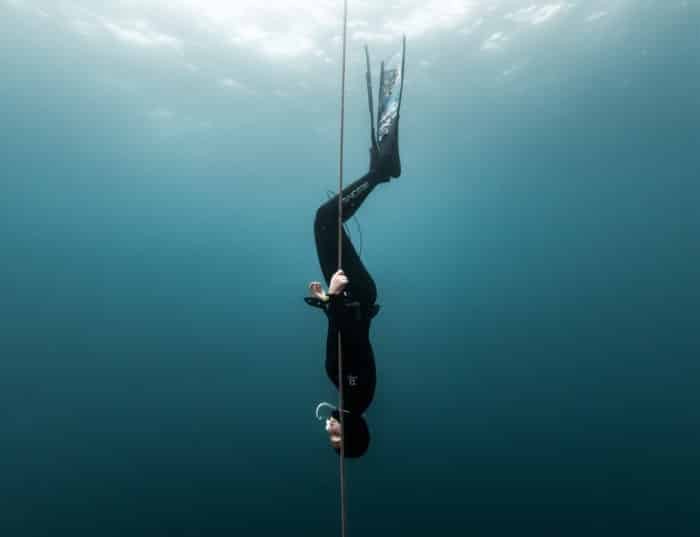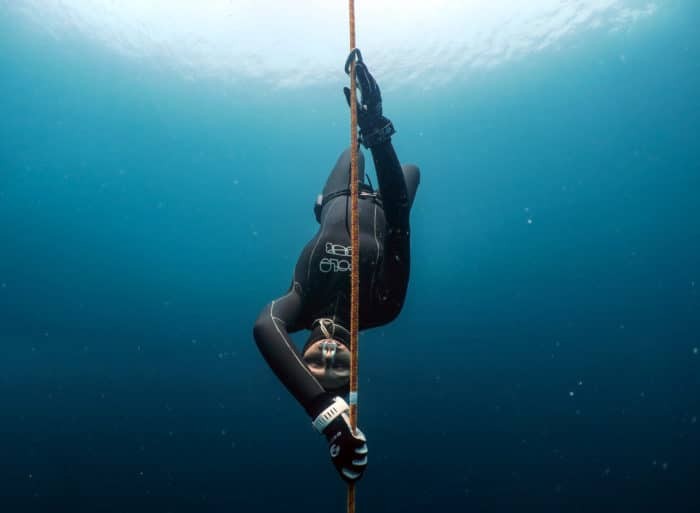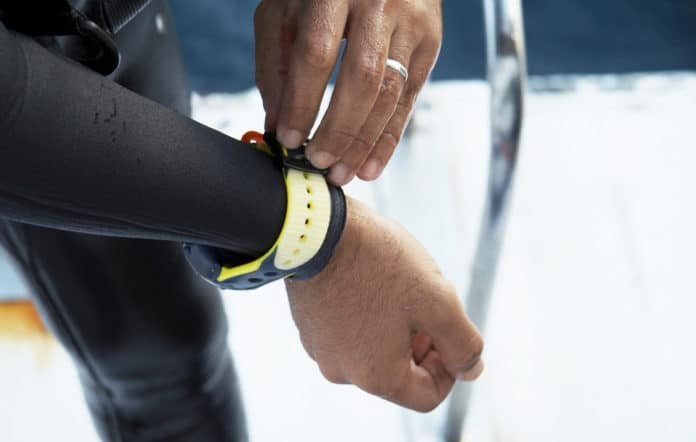Dive computers are expensive pieces of equipment. In fact, these computers can be so expensive that they might be the last piece of equipment that a freediver invests in, instead of focusing on more affordable items. At the beginning of a freediver’s journey, a dive computer might not be a necessary expense, but as you start incorporating freefall into your dives and going deeper, a dive computer becomes much more critical in ensuring safety, standardizing and improving dives, and verifying progress.
Surface Interval Times
The risk of decompression sickness (DCS) is sometimes mistakenly attributed only to scuba divers, but it can also be a risk for freedivers and especially for spearfishers. Since depth and pressure increase during our dives, the partial pressure of nitrogen that is in our lungs from our final breath becomes higher than natural saturation at the surface. If too much nitrogen is accumulated and is not given time to dissolve at the surface, it can return to gas form in our blood and muscle tissues, which leads to DCS. If we do not give our bodies enough time at the surface to release the accumulated nitrogen, we run into the risk of developing DCS. DCS in its most severe form can cause paralysis or death, so taking the proper precautions are critical.
Deep divers are aware that, after the 55m (180ft) mark, deep dives should only be limited to one per day. Even with shallower dives, if you dive repeatedly and do not have long enough surface interval time (this is for you, freediving instructors and fun divers), you can become at risk for developing DCS. There are many factors at work that can make one more susceptible to develop DCS, whether it is age, physical fitness, dehydration, physical injury, etc. Here are two simple formulas for freedivers to follow to reduce the risk of DCS:
For dives that are shallower than 30m (98ft): surface interval = dive time x 2
For dives that are 30m (98ft) and deeper: surface interval = maximum depth (in meters) / 5
This means a dive to 25m (82ft) that takes 1:30 should result in a 3-minute surface interval. A dive to 45m (147ft) should result in a 9-minute surface interval.
Ascent speed is also a factor, so make sure that you are not ascending faster than 1 to 1.5m/s (3 to 5ft/s). These are basic formulas and are not foolproof, but they can work as a basis for establishing the absolute minimum surface interval times. Dive computers help measure dive time and surface interval time in a simpler way, which helps freedivers stay safe in the water.
Freefall Alarm

As the freefalling rule of thumb goes: a freediver should be neutral at around 1/3 of their total depth, but no less than 10m (32ft). The freefall should start around 5-7m (16-22ft) after reaching the point of neutral buoyancy to ensure being sufficiently negative for a good freefall speed. This is where a dive alarm becomes very useful. Those who count rope markings, fin cycles, or pulls to measure when to start freefall have to keep their mind constantly occupied until freefall begins. This can negatively affect relaxation during the dive, and might not be accurate every single time.
Others may also go off of their feelings, and start freefall when they detect their buoyancy change. This method cannot guarantee precision, and if you are working on increasing depth, it is important to avoid moving more than you have to in order to conserve oxygen, and also avoiding freefalling too early and having an extended dive time. Why preoccupy your mind with when to start freefall when you can have a nice little dive alarm that notifies you on your wrist, inside of your hood, or around your neck weight, giving you accuracy and taking away added stress?
Calculating Dive Time and Speed
At some point in your freediving career, you will need to concentrate on certain aspects of your dive in order to get the most out of your oxygen supply. This could be any number of factors, but there are two important factors that you can easily check on with the help of a dive computer: dive time and speed. Analyzing these two factors can greatly help you check if you are using your time efficiently during your breath-hold.
You can measure each section of your dive separately to see what you need to work on: how long it takes you to get to the first 10m, measuring the speed of the freefall (1m/s is a good freefall speed) in sections (such as from 20m to 30m, then 30m to 40m, and so on), how long it takes you to complete your turn and begin your ascent, and then the general ascent time and whether it is too fast or slow. Measuring only the total dive time can be flawed, as it may hide a slow freefall by having a quick ascent, which is why it is critical to be able to analyze every part of your dive. In order to get the most out of your dive computer, make sure to set the sample rate to 1s, so that you can measure every single second of the dive.
Verifying Depth

Let’s be honest: not everyone has the most accurate line-markings on their ropes. It is tough to measure progress if you go from one line to another and find that, since the line is not accurately marked, the dive you thought you did was actually a few meters shorter than what you were going for. Current can also affect line depth, shaving off any number of meters. When diving on a line (especially if you are on an open line) or even measuring neutral buoyancy, a dive computer is a significant tool for keeping things precise and assessing true progress.
Final Thoughts
Dive computers may be expensive, but they are a critical tool to have if you want to focus on safety, increasing depth, and measuring progress. This does not necessarily mean you have to buy a brand new one; you can buy a used one, share one with a dive buddy, or check if a freediving center near you has dive computers available for rent. Just like in any other extreme sport, proper equipment is a significant and necessary investment, so take freediving as seriously as you would take skydiving or rock climbing.

